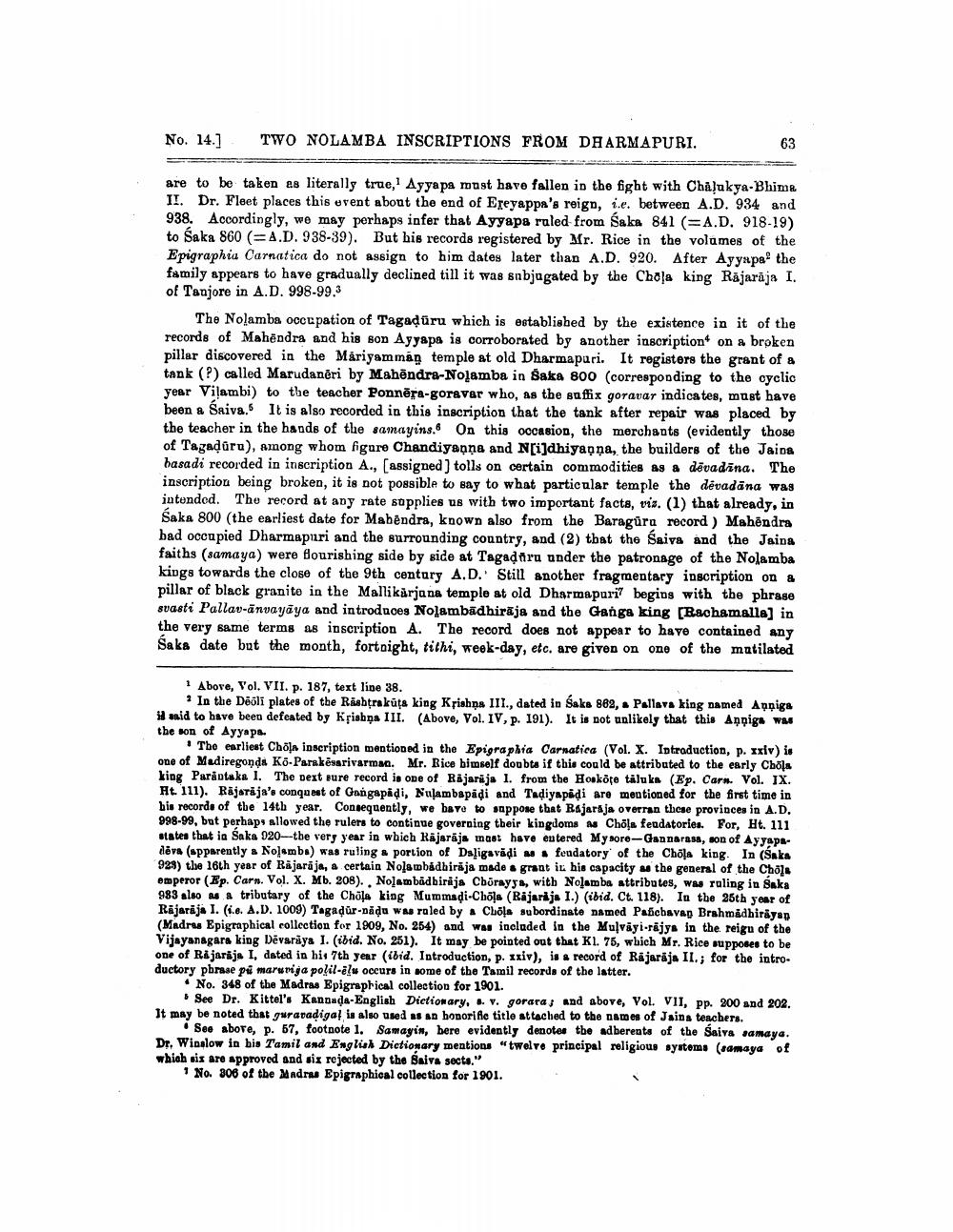________________
No. 14.]
TWO NOLAMBA INSCRIPTIONS FROM DHARMAPURI.
63
are to be taken as literally true, Ayyapa must have fallen in the fight with Chalukya-Bhima II. Dr. Fleet places this event about the end of Ereyappa's reign, i.e. between A.D. 934 and 938. Accordingly, we may perhaps infer that Ayyapa ruled from Saka 841 (=A.D. 918-19) to Saka 860 (A.D. 938-39). But his records registered by Mr. Rice in the volumes of the Epigraphia Carnatica do not assign to him dates later than A.D. 920. After Ayynpa the family appears to have gradually declined till it was subjugated by the Chola king Rājarāja I. of Tanjore in A.D. 998-99.3
The Nolamba occupation of Tagadūru which is established by the existence in it of the records of Mahendra and his son Ayyapa is corroborated by another inscription on a broken pillar discovered in the Máriyamman temple at old Dharmapuri. It registers the grant of a tank (?) called Marudanéri by Mahēndra-Nolamba in Baka 800 (corresponding to the cyclic year Vilambi) to the teacher Ponnēra-goravar who, as the suffix goravar indicates, must have been a Saiva. It is also recorded in this inscription that the tank after repair was placed by the teacher in the hands of the samayins. On this occasion, the merchants (evidently those of Tagadura), among whom figure Chandiyaņņa and N[i]dhiyaņņa, the builders of the Jains basadi recorded in inscription A., (assigned ) tolls on certain commodities as a dēvadīna. The inscription being broken, it is not possible to say to what particular temple the dévadāna was intended. The record at any rate supplies us with two important facts, vis. (1) that already, in Saka 800 (the earliest date for Mahendra, known also from the Baragūra record ) Mahendra bad occupied Dharmapuri and the surrounding country, and (2) that the Saiys and the Jaina faiths samaya) were fourishing side by side at Tagadiru under the patronage of the Nolamba kings towards the close of the 9th century A.D. Still another fragmentary inscription on & pillar of black granite in the Mallikarjana temple at old Dharmapuri? begins with the phrase svasti Pallav-ānvayāya and introduces Nolambādhiraja and the Ganga king (Rachamalla) in the very same terms as inscription A. The record does not appear to have contained any Saka date but the month, fortnight, tithi, week-day, etc. are given on one of the matilated
1 Above, Vol. VII. p. 187, text line 38.
* In the Deoli plates of the Rashtra küta king Krishna III., dated in Saks 882, Pallava king named Appiga i wid to have been defeated by Krishna III. (Above, Vol. IV, p. 191). It is not unlikely that this Annige was the son of Ayyaps.
The earliest Chola inscription mentioned in the Epigraphia Carnatica (Vol. X. Introduction, p. xxiv) is one of Madiregonda Ko-Parakēsarivarmaa. Mr. Rice bimself doubts if this could be attributed to the early Chols king Paraptaka I. The next sure record is one of Räjarija 1. from the Hosköre taluks (Ep. Cars. Vol. IX. Ht 111). Rajaraja's conquest of Gangapidi, Buļambapädi and Tadiyapadi are mentioned for the first time in bis records of the 14th year. Consequently, we have to soppose that Rajaraja overran these provinces in A.D. 998-99, but perhaps allowed the rulers to continue governing their kingdoms as Chola feudatories. For, Ht. 111 states that ia Saka 920--the very year in which Rajaraja mast have entered Mysore-Gannarasa, son of Ayyapadēva (apparently a Nolamba) was ruling a portion of Daligavādi m feudatory of the Chola king. In (Suka 928) the 16th year of Rajaraja, a certain Nolambadhiraja made a grans it his capacity the general of the Chola emperor (Ep. Carn. Vol. X. Mb. 208). . Nolambådbiraja Cborayys, with Nolamba attributes, was ruling in Baka 983 also as a tributary of the Chāļa king Mummadi-Choļs (Rajarijs I.) (ibid. Ct. 118). In the 25th year of Räjarija I. (ic. A.D. 1009) Tagadur-Dada was raled by a Choļs subordinate named Pašicbavap Brahmadhirayap (Madru Epigraphical collection for 1909, No. 254) and was included in the Mulviyi rijys in the reigu of the Vijayanagara king Devaraya I. (ibid. No. 251). It may be pointed out that Kl. 75, which Mr. Rice supposed to be one of Rajaraja I, dated in his 7th year (ibid. Introduction, p. xxiv), is record of Rajaraja II.; for the introductory phrase på marumiga polil-elu occurs in some of the Tamil records of the latter.
• No. 348 of the Madras Epigraphical collection for 1901.
See Dr. Kittel's Kannada-English Dictionary, #. v. gorara and above, Vol. VII, pp. 200 and 202. It may be noted that guraradiga! is also used as an honorifie title attached to the names of Jsins teachers.
• Seo abore, p. 57, footnote 1. Samayin, bere evidently denotes the adberents of the Saiva samaya. Dr. Winslow in bis Tamil and English Dictionary mentions "twelve principal religious systems (samaya of which sis are approved and six rejected by the Saiva sects."
No. 306 of the Madrus Epigraphical collection for 1901.




